Papers by Paolo Ciuccarelli

S.H.E.D. – Design for Emergency
This presentation introduces the Design for Emergency research project, an open design platform l... more This presentation introduces the Design for Emergency research project, an open design platform launched in 2020 at the Center for Design (Northeastern University, Boston) to collaborate on design solutions and confront the COVID-19 emergency. Design for Emergency is led by Dr Sara Colombo and Prof Paolo Ciuccarelli and gathers a global team of researchers across 11 countries. They will discuss the first design activity built on results of an international survey and a design challenge in Brazil. As well as offering insights into how this research project reconfigures design needs and purpose, their introduction provides a refreshing take on a global understanding of the role that design challenges perform in order to build solutions that address the problems and challenges of the pandemic. Dr Rhiannon Jones and Dr Victoria Barker are the lead UK Research partners. Dr Rhiannon Jones and Dr Victoria Barker will share plans for the UK research for this project, building further survey insights and creating a S.H.E.D open design challenge for UK-based designers and artists to test out some of the internationally proposed designs generated as a result of this research initiative.CHEAD DESI
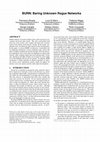
Manual analysis of security-related events is still a necessity to investigate non-trivial cyber ... more Manual analysis of security-related events is still a necessity to investigate non-trivial cyber attacks. This task is particularly hard when the events involve slow, stealthy and large-scale activities typical of the modern cybercriminals' strategy. In this regard, visualization tools can effectively help analysts in their investigations. In this paper, we present BURN, an interactive visualization tool for displaying autonomous systems exhibiting rogue activity that helps at finding misbehaving networks through visual and interactive exploration. Up to seven values are displayed in a single visual element, while avoiding cumbersome and confusing maps. To this end, animations and alpha channels are leveraged to create simple views that highlight relevant activity patterns. In addition, BURN incorporates a simple algorithm to identify migrations of nefarious services across autonomous systems, which can support, for instance, root-cause analysis and law enforcement investigations.
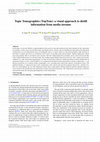
Computer Graphics Forum, 2019
In this paper we present Top Tom, a digital platform whose goal is to provide analytical and visu... more In this paper we present Top Tom, a digital platform whose goal is to provide analytical and visual solutions for the exploration of a dynamic corpus of user‐generated messages and media articles, with the aim of i) distilling the information from thousands of documents in a low‐dimensional space of explainable topics, ii) cluster them in a hierarchical fashion while allowing to drill down to details and stories as constituents of the topics, iii) spotting trends and anomalies. Top Tom implements a batch processing pipeline able to run both in near‐real time with time stamped data from streaming sources and on historical data with a temporal dimension in a cold start mode. The resulting output unfolds along three main axes: time, volume and semantic similarity (i.e. topic hierarchical aggregation). To allow the browsing of data in a multiscale fashion and the identification of anomalous behaviors, three visual metaphors were adopted from biological and medical fields to design visua...
Designing connected places
Ricerche e progetti prodotti da una scuola estiva internazionale a Torino in occasione del World ... more Ricerche e progetti prodotti da una scuola estiva internazionale a Torino in occasione del World Design Capital, in cui si sono sviluppati sei temi (Active Welfare,Open and safe place,Food network, Simbiotic production,Multy Mobility,Complexity Maps) in comunione con le comunit\ue0 locali e le esigenze del territorio
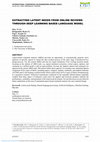
Proceedings of the Design Society
Aspect-based sentiment analysis (ABSA) provides an opportunity to systematically generate user... more Aspect-based sentiment analysis (ABSA) provides an opportunity to systematically generate user's opinions of specific aspects to enrich the idea creation process in the early stage of product/service design process. Yet, the current ABSA task has two major limitations. First, existing research mostly focusing on the subsets of ABSA task, e.g. aspect-sentiment extraction, extract aspect, opinion, and sentiment in a unified model is still an open problem. Second, the implicit opinion and sentiment are ignored in the current ABSA task. This article tackles these gaps by (1) creating a new annotated dataset comprised of five types of labels, including aspect, category, opinion, sentiment, and implicit indicator (ACOSI) and (2) developing a unified model which could extract all five types of labels simultaneously in a generative manner. Numerical experiments conducted on the manually labeled dataset originally scraped from three major e-Commerce retail stores for apparel and footwear...
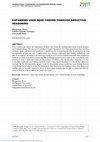
Proceedings of the Design Society
Prior research has shown the importance of latent user needs for enabling innovation in early pro... more Prior research has shown the importance of latent user needs for enabling innovation in early product development phases. The success of a product is largely dependent on to what extent the product satisfies customer needs, and latent user needs play a significant role in impacting the way the product or service unexpectedly delights the user. Complications arise because traditional need finding methods are not able to account for the nuances of latent user needs. A user's need is multidimensional while traditional methods are built on deductive reasoning. The traditional method isolates parts of the user's needs, only pointing to what is deducible within its search space. To address this, we introduce abduction as a way to broaden traditional need finding methods. From a logic based argument it is shown that abduction accounts for the dimensionality of user needs by integrating various traditional need finding theories using design knowledge to isolate the latent need. This...
Occhiali e innovazione, tra stile e design
Ottagono Rivista Trimestrale Di Architettura Arredamento E Industrial Design, 2000
The Promising Cases Repository: using ICT for supporting research activities
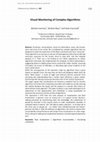
2CO Communicating Complexity. Contributions from the 2017 Tenerife Conference, 2020
Purchases, conversations, access to information, music and movies: more and more of our online li... more Purchases, conversations, access to information, music and movies: more and more of our online life is mediated by complex algorithms that are designed to make the experience of the Web customized and more "personal". These algorithms can process an amount of heterogeneous data that would take enormous resources for the human mind to cope with, and find valuable patterns in it. Their use is not limited to our online experience as similar algorithms have been also implemented, for example, to inform policymakers: suggesting where to deploy police forces around the urban context, assessing criminality risk scores of offenders, or allocating high school students to the most suited school. While the consequences of the decisions made by algorithms have a great impact on people's lives, the way they are built and designed makes them de facto "black boxes": a series of legal and technical barriers prevents from accessing and understanding how a certain input influences a given output. Overseeing their decision processes becomes then of the utmost importance. This paper argues that visualizations can become a powerful tool to monitor algorithms and make their complexity accessible and usable by visually showing the relation between the inputs and the outputs in a manner that mimics an observational study approach. The paper analyzes a case study developed as an experiment to test opportunities and criticalities in using visualization to represent the presence and the activity of algorithms. This represents a shift from the main purpose of visualizations and Data Visualization in general: since its strong suit is to support human decisionmaking processes by transforming data into knowledge, the substitution of people by machines in this activity seems to make visualizations obsolete. A computer doesn't need to "see" the data to make a decision-or at least not in the same way as people do-no matter how multidimensional and heterogeneous the data is. With the diffusion of algorithms, the need to inspect their accountability and performance will simply move visualizations at a later stage. From a decision-making tool visualization becomes a monitoring and awareness tool.
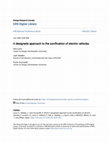
Proceedings of DRS
There is a growing interest in framing sound-related areas of research such as sonification, soni... more There is a growing interest in framing sound-related areas of research such as sonification, sonic interaction design and product sound design in terms of design methodologies. Sound designers are seeking to structure a field traditionally characterised by tacit knowledge in terms of explicit design processes, tools and methods, to increase the reach and impact of the field. In this paper, we describe the first two stages of a commercial sonification project for the design of sounds for Electric Vehicles. The project was developed applying a design methodology that integrates a specific tool (the sonification canvas), which we describe in detail. We approach the creation of sounds for Electric Vehicles as a designerly endeavour with the goal of contributing to the transition of sound design from a heterogenous, practice-based field to a structured discipline that can enrich the creation of fulfilling experiences.
Data Sonification Archive
Venezia, la ‘Festa Mobile’: per un atlante in fieri. Luoghi, figure e forme della favola antica nel primo Rinascimento
Un portale per il disegno industriale
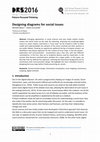
Emerging approaches in social sciences and new media studies involve inquiry into social issues v... more Emerging approaches in social sciences and new media studies involve inquiry into social issues via the web. By collecting, analysing and visualising digital traces (i.e. posts, tweets, comments), a “issue map” can be created in order to make visible and understandable the network of the actors involved and their position in any public debate. Drawing on experiences gathered during a European project, we identified a two-phases-approach for the creation of issue maps. In the two phases exploration and communication visualisations play a key role, with two different connotations: in the first, they act as analytical devices used by researchers. In the second, they become communicative artefacts for a larger public. In this paper, we describe how we defined this approach, outlining the theoretical background and its connections with communication design. We highlight the main criticalities found in designing the issue maps before finally presenting our results.
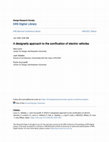
Proceedings of DRS2022: Bilbao, 25 June- 3 July, 2022
There is a growing interest in framing sound-related areas of research such as sonification, soni... more There is a growing interest in framing sound-related areas of research such as sonification, sonic interaction design and product sound design in terms of design methodologies. Sound designers are seeking to structure a field traditionally characterised by tacit knowledge in terms of explicit design processes, tools and methods, to increase the reach and impact of the field. In this paper, we describe the first two stages of a commercial sonification project for the design of sounds for Electric Vehicles. The project was developed applying a design methodology that integrates a specific tool (the sonification canvas), which we describe in detail. We approach the creation of sounds for Electric Vehicles as a designerly endeavour with the goal of contributing to the transition of sound design from a heterogenous, practice-based field to a structured discipline that can enrich the creation of fulfilling experiences.
Meta-design in the complexity of global challenges
Proceedings of DRS

DIID, 2022
Design (research) has a natural tendency toward disciplinary promiscuity: it is the inevitable co... more Design (research) has a natural tendency toward disciplinary promiscuity: it is the inevitable consequence of its interdisciplinary nature (Friedman, 2003). But the farther and deeper it goes in exploring and weaving new connections and relationships, the more its essence must be clear and remain solid. Capturing and understanding the interconnected nature of design is thus crucial for interdisciplinary design research. Three initiatives have been activated at the Center for Design (Northeastern University), to ground the mission of fostering interdisciplinary design research: (a) observe and understand the status and the evolution of design as a discipline and a practice through a Design Observatory (DO); (b) catalyze design forces around a current global-social issue and create the conditions for them to learn and act through the Design for Emergency open platform (Colombo & Ciuccarelli, 2020); (c) challenge the innate promiscuity of design by exploring/(bed)testing new potential ...
Chair: Prof. Francesco Trabucco Field of study Held at Politecnico di Milano university, the Doct... more Chair: Prof. Francesco Trabucco Field of study Held at Politecnico di Milano university, the Doctorate in Design Research is created and managed by the Industrial Design, Arts, Communication and Fashion Department, INDACO, in cooperation with the Department of Mechanics and the Department of Chemistry, Materials and Chemical Engineering. Politecnico di Milano research doctorate courses aim to build the skills needed to perform highly qualified research jobs in manufacturing and service enterprises, the public sector, and the university. The scientific field to which this course belongs is industrial design. Its interdisciplinary relationships include the philosophy and theory of language, art history, design, science of materials and technology, industrial engineering, decision making, and computer science.
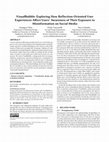
CHI Conference on Human Factors in Computing Systems Extended Abstracts
Current solutions addressing misinformation on social media appear to rely on the misconception t... more Current solutions addressing misinformation on social media appear to rely on the misconception that misinformation is predominately spread by Artificial Intelligence (AI). However, the proliferation of false news is mainly due to humans. Solutions to curb misinformation should therefore emphasize human behavioral interventions, rather than focus solely on curbing AI bots. In this study, we analyze social media users' behaviors by means of a user journey. We create VisualBubble, a design probe that encourages reflection-oriented user experiences during news consumption on social media. We test our design probe with 10 users, to determine its effectiveness in increasing users' critical reflection on their news consumption behaviors. The initial findings show that VisualBubble can contribute to more critical attitudes towards the news that users are exposed to and, therefore, has the potential to mitigate social media misinformation. CCS CONCEPTS • Human-centered computing → Visualization design and evaluation methods.






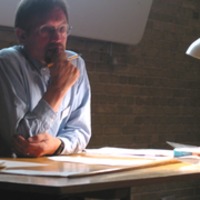




Uploads
Papers by Paolo Ciuccarelli
In our call, we are looking for a diversity of research contributions revolving around networks in culture, networks in art, networks in the humanities, art about networks, and research in network visualization. Focussing on these five pillars that have crystallized out of our previous meetings, the 2013 symposium strives to make further impact in the arts, humanities, and natural sciences.
Running parallel to the NetSci2013 conference, the symposium provides a unique opportunity to mingle with leading researchers in complex network science, potentially sparking fruitful collaborations.
As in previous years, selected papers will be published in print, both in a Special Section of Leonardo Journal MIT-Press and in a dedicated Leonardo eBook MIT-Press."
La ristampa coincide con uno degli obiettivi dichiarati: promuovere ed allargare la rete del design identificata nel progetto, offrendo alla comunità del design un’occasione di unificazione attraverso la condivisione di una metodologia e di alcuni strumenti per la gestione del proprio patrimonio informativo, documentale, e quindi culturale.
Some of these communities have developed and creatively act into digital spaces of the net, they explore and push forward ICT technology boundaries: everyday we observe on internet flourishing of sources and authorities, new way to organize informations, public heritage worked out by different people and organizations; they show much more richness everyday and become more and more interesting. Current research paths on creativity support tools investigate creative process as situated cognition activities in an physical and technological space made up of tools, such as creativity labs for innovation, and frameworks for knowledge intensive activities. (e.g. L3D lab in Chicago, Fraunhofer Institutes in Germany). Researches find out that creativity spaces should be differently designed for each creativity action, which manages a particular kind of knowledge and needs to be supported by specific tools. Design activity is linked to design spaces. It’s a knowledge transfer process based on tools, from pencil to cognitive maps: knowledge steadly shapes until it becomes designed artifact. It’s creative and cooperative action itself, presenting same attributes as network communities.
The ongoing research is hosted at Politeca, a Design Knowledge Centre at Politecnico di Milano; it focuses on network tools placed into design spaces, exploring which kind of support they can provide to design processes. We're trying out use the use and the need of tools in design contexts by design students community (in faculty labs and courses) and by designers’ city community (knowledge at work in different design teams), both acting design processes and experiencing knowledge needs. We study design activities “in situ” through participant observation methods from ethnomethodology; we create a sort of “designers’ observatory” in which we explore action research and we stand on it from the point of view of designers, also as researchers.
In order to turn research findings into actions, forthcoming phases will verify emerged needs of knowledge by allowing designers to experience directly with designed tools, and providing to them framework of tools and methods to use.
Network tools are technology to act and experience knowledge, consistently with our idea that knowledge follows from sharing and that design activity has sharing expertise. Proceeding from there, we aim shape toolkits for design activities to enhance sharing creative processes and contribute to develop a knowledge base for design made up by dialogue between resources and experiences.
Heeding the perspective of Design discipline dealing with languages, the Communication Design could afford the creation of visual and interactive languages relevant to the representations of Complex systems, creating shared visions within multi-actor contexts. In this sense it can facilitate dialogues within participatory actions and verify the potential of communication artifacts in supporting and externalizing sustainable and self-adaptive learning processes.
Assuming this contribution of design in the multidisciplinary framework of sustainability, a didactic and research initiatives has been established since 2004 at the Master Degree in Communication Design at the Milan Polytechnic. Using complexity as a keyword to understand reality, combining it with a continuous research for information aesthetics and representation, the The DensityDesign lab explores the emergent relationships among communication design, information visualization and complex systems. The paper will discuss the relevance of this approach in dealing with the social issues and the data dimension, and the impact of this practice in the master students' comprehensive background.
The design approach involves the ability to select results from various disciplinary fields, activating a trans-disciplinary circulation of concepts. Designers should use their skills to facilitate the emergence of a system, rather than concentrating on finding solutions to specific and well-identified problems. The focus should be on developing tools that can be self-adaptive, continuously modifiable and improvable by utilizing the ongoing process of wicked problem transformation. Social complexity requires new processes fundamentally attuned to the social and conversational nature of decision-making and design work; these processes should enable an increasingly valuable interaction level and dialogue among the actors of a social system. And considering the Design discipline in respect to language, Communication Design could allow for the creation of visual and interactive languages relevant to the representations of Complex systems, thus creating shared visions within multi-actor contexts. In this sense, communication design can facilitate dialogues within participatory actions, and verify the potential of communication artifacts in supporting and externalizing sustainable and self-adaptive learning processes."
La crescita esponenziale delle tecniche e degli strumenti di informazione digitale non innesca semplicemente una trasformazione delle pratiche quotidiane e delle risorse cognitive: ciò che muta nel contesto delle attuali forme elettroniche è anche il modo di percepire oggetti, ambienti, persone, concetti e idee. Il pensiero cambia così nel suo atto costitutivo e proiettivo, venendo reinvestito e ri(pro)dotto dagli stessi media che lo articolano. In questo volume si porta l’indagine sull’interazione tra le forme canonizzate e rigide delle risorse di una cultura informatica e le reti polivoche del pensiero, ricostruendo nel paradigma delle architetture liquide un modello trasversale di rilettura dei dispositivi di conoscenza e di comunicazione. Ciò che si cerca di illustrare è la forma di una recente iper-cultura che, lungi dall’essere ravvisata come diretta deviazione della odierna speculazione commerciale contemporanea, e lontana dalla dissacrazione delle forme storiche di produzione intellettuale, si propone come l’incarnazione elettronica del sentimento collaborativo e della volontà collettiva propria di un mondo dove i legami interpersonali si rimodulano tra accesso e scambio, tra reti brevi e reti lunghe, tra insiemi di segni liquidi, che mutano la loro cifra significativa ogni volta che li si rilegge e li si reinterpreta. Le architetture liquide si propongono così come un percorso da affrontare non solo alla luce degli aspetti tecnologici di fattibilità dei dispositivi, ma in unione con l’apparato culturale di ogni società che vive l’evoluzione dei media e dei loro caratteri peculiari di velocità e di interattività: in queste nuove “architetture” si ravvisa il momento di rottura con il normale riscontro esegetico di una forma antica del sapere umano, condizione indispensabile per poter tradurre le pratiche, confinate in paradigmi rigidi e schemi sociali propri della tecnica, in un ambito di applicazione in cui il patrimonio umanistico e filosofico gioca un ruolo di disvelamento assolutamente nuovo.
Design Open Source esplora le opportunità e i limiti della possibile convergenza di due fenomeni, che stanno cambiando e ampliando sensibilmente i modi, gli strumenti e le problematiche del progetto. Il primo fenomeno è quello della graduale apertura del processo progettuale dalle imprese verso l’utente finale, coinvolto in modo sempre più diretto in reti di collaborazione che determinano le caratteristiche dell’offerta. Un cambiamento spinto dall'evoluzione dei mercati, sostenuto dalle innovazioni tecnologiche, ancora da valutare appieno però negli esiti. Il secondo fenomeno è l’emergenza di iniziative di creatività (progettazione) diffusa, che si organizzano dal basso, non solo nella produzione e progettazione di prodotti immateriali e servizi digitali. A partire dal mondo del freesoftware, gli utenti condividono e praticano un approccio alla conoscenza radicalmente nuovo, che apre la strada ad una nuova etica del progetto: la conoscenza, e con essa l'innovazione che ne deriva, sono beni pubblici, che traggono vantaggio più dalla condivisione e dalla diffusione che dalla protezione. La possibilità di una convergenza di questi due fenomeni pone il design di fronte a nuove opportunità, nuove sfide, nuove problematiche, che emergono dal testo con la consapevolezza che gli esiti possibili sono ancora in larga parte da immaginare e, ovviamente, da co-progettare.